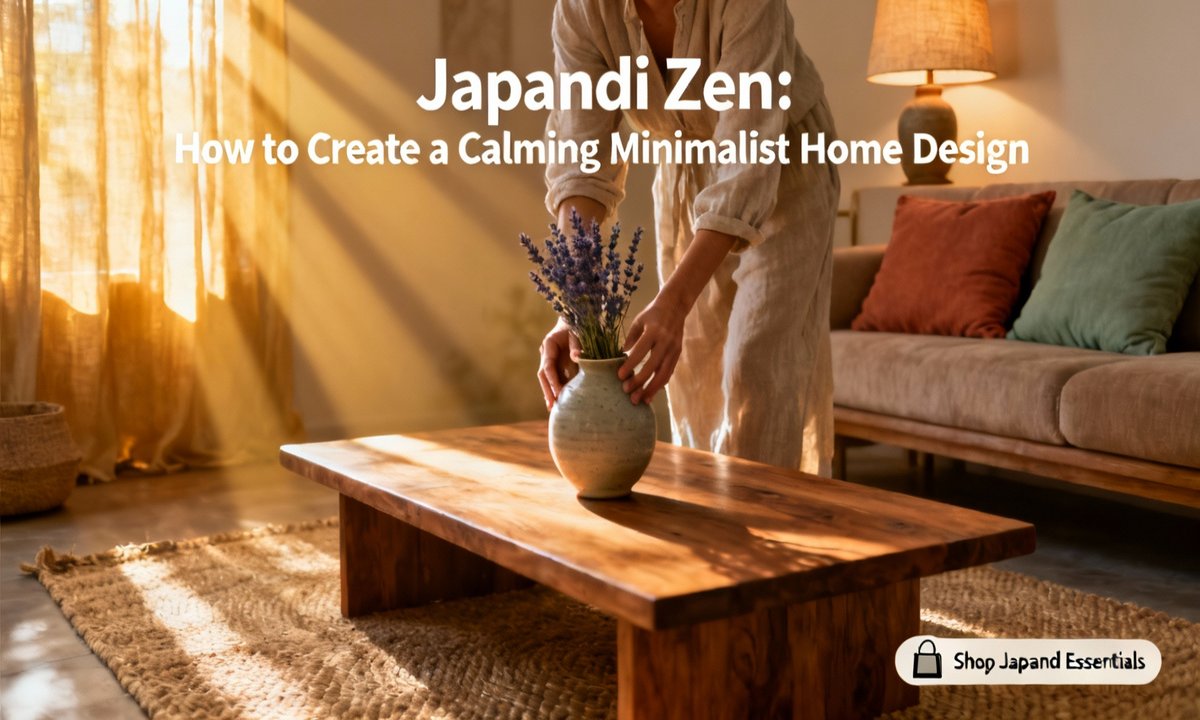Are you captivated by the elegant simplicity of Japanese design and the comforting warmth of Scandinavian aesthetics? Japandi Zen offers a unique solution, blending mindful living with uncluttered beauty. Discover how to imbue your home with calming sophistication, practical functionality, and timeless appeal, drawing on expert insights and real-world design approaches.
Understanding Japandi Zen: A Harmonious Blend
Defining Japandi and its Core Philosophy
Japandi style harmonizes Japanese minimalism with Scandinavian coziness, uniting Eastern Zen principles with Nordic practicality. Imagine an uncluttered, light-filled space that feels both deliberate and profoundly soothing. This philosophy embraces intentional living, natural materials, and a palette that calms the senses, as explored in a
complete guide to Japandi interiors.
Key Elements of Japandi Style: Simplicity, Functionality, and Serenity
Japandi interior design thrives on clean lines, furniture chosen for purpose, and tranquil surroundings. Adopting a “less is more” ethos, every item is selected for its utility and aesthetic value. Fundamental principles include thorough decluttering, the use of neutral tones, and valuing quality craftsmanship over excessive adornment.
The Allure of Japandi Zen in Modern Living
Cultivating Calm and Mindfulness
A Japandi Zen home offers more than visual peace; it fosters daily mindfulness. By removing clutter, you inherently reduce stress, creating a serene sanctuary. This design approach nurtures relaxation, which is increasingly vital for wellness-focused American lifestyles. Learn more about
mood-boosting interiors and their calming effects.
Embracing Sustainable and Minimalist Lifestyles
Japandi Zen perfectly aligns with sustainable home design practices. Utilizing renewable, natural materials not only promotes calm but also demonstrates environmental responsibility. Incorporate
sustainable home products and consider upcycled or vintage pieces to reflect an eco-conscious spirit within your living space.
Why Japandi Resonates in Contemporary Homes
With growing emphasis on home well-being, Japandi offers a much-needed escape from daily chaos. Its focus on sustainability, digital wellness, and personalization makes this style highly relevant today, especially for those seeking peace and a fresh start. Its timeless appeal promises enduring comfort.
Crafting Your Japandi Zen Sanctuary: Essential Principles
The Beauty of Natural Materials and Soothing Tones
Opt for wood, bamboo, stone, linen, and organic textiles in your furniture and decor. These tactile elements add subtle warmth, creating a connection to the outdoors. Complement them with soft whites, beiges, greys, and gentle pastels for a truly
neutral tones decor that evokes profound tranquility.
Minimalism with a Cozy Touch: The Hygge Influence
While minimalist home design can sometimes feel sparse, Japandi beautifully balances this with “hygge”—the Scandinavian concept of cozy comfort. Soften spaces with plush throws, textured rugs, and layered cushions in muted, earthy hues. These elements invite comfort and gentle relaxation, complementing
essential home organization tools.
Integrating Zen Concepts: Wabi-Sabi, Harmony, and Balance
Japandi Zen embraces wabi-sabi, celebrating beauty in imperfection and aged finishes. Mix handmade ceramics, stoneware, or glass for unique touches. Keep arrangements simple to foster harmony and balance, while artful placements of plants and natural motifs further enhance the Zen atmosphere.
Thoughtful Inclusion of Sustainable and Vintage Pieces
Prioritize eco-friendly materials and make sustainability a core consideration. Whether through reclaimed wood, upcycled decor, or items from local artisans, seek ways to introduce unique, storied elements into your home. Discover inspiring
upcycled furniture ideas to transform your space.
A Room-by-Room Guide to Japandi Zen
Living Room: Flow, Function, and Tranquility
Begin with a low-profile wooden coffee table and a neutral-toned sofa. Keep pillows minimal but plush, accompanied by a few nature-inspired, handmade accents. Wall art should be sparse—just enough to add intrigue without overwhelming the space.
Curious about creative ways to maximize tranquility? Explore
small space decor ideas specifically tailored for minimal, beautiful living rooms, optimizing both comfort and aesthetics.
Bedroom: A Haven for Rest and Rejuvenation
Choose a platform bed in light wood paired with crisp or linen bedding for ultimate comfort. Minimal artwork, perhaps a calming print or an elegant shoji-style screen, grounds the peaceful mood. Keep surfaces clear, with only essentials remaining, to ensure a truly restful atmosphere.
Kitchen and Dining: Effortless Simplicity
Integrate built-in appliances or use paneling to ensure a seamless visual flow. Wooden or stone countertops emphasize a connection with nature, while open shelving or hidden storage minimizes clutter. A few decorative items, like a handcrafted vase or bowl, tastefully complete the look.
Bathrooms and Outdoor Spaces: Extending Serenity
Maintain a minimalist aesthetic in bathrooms with natural stone, bamboo accessories, and soft lighting. If you have a patio or balcony, extend indoor-outdoor living with raw-edged benches, potted bamboo, and sculptural plants, creating a private Zen sanctuary.
Practical Steps for a Japandi Transformation
The Art of Decluttering and Mindful Editing
Start by removing all non-essential items from your space. This doesn’t mean creating empty rooms, but rather intentional ones. Store belongings thoughtfully using baskets, built-in solutions, or multi-functional furniture. Our guide on
essential home organization tools can help you achieve a clutter-free reset.
Conscious Selection of Furniture and Decor
Seek Japandi furniture characterized by simple forms and clean lines. Options crafted from natural wood or bamboo offer timeless appeal and are environmentally friendly. Introduce personality with one or two unique handmade items to foster authenticity within your decor.
Designing for Openness and Natural Light
Arrange rooms to encourage relaxation, allowing for a sense of spaciousness and flow. Position furniture to maximize natural light throughout the day. Layer lighting with diffused lamps or sconces to maintain a calm ambiance. Explore tips for
calming home interiors with color for further inspiration.
Bringing Nature Indoors: Plants and Organic Textures
Introduce greenery with oversized plants or simple vases holding sculptural branches. Organic textiles—linen curtains, wool throws, handwoven rugs—soften the space while enhancing a connection to nature. These subtle touches cultivate the tranquility inherent to Japandi Zen.
Common Pitfalls to Avoid in Japandi Design
When embracing Japandi Zen, avoid overcrowding your space; even beautiful objects lose their appeal when there are too many. Remember that minimalism should not sacrifice comfort; layer soft furnishings and gentle textures to nurture coziness. Finally, do not skip personalization; a true Japandi space reflects its inhabitants, making it feel uniquely like home.
Frequently Asked Questions About Japandi Style
Japandi vs. Traditional Japanese or Scandinavian Design
Japandi uniquely combines the Japanese appreciation for simplicity and natural materials with the coziness and functionality of Scandinavian design. This fusion results in a distinctly balanced and harmonious living space, drawing the best from both influential aesthetics.
Navigating Color Palettes
While muted tones predominantly define Japandi, accents of black, deep brown, or subdued pastels are welcome additions. These thoughtful touches can introduce contrast and depth without disrupting the overall sense of harmony and tranquility.
Japandi for Smaller Spaces
Absolutely! Japandi’s inherent focus on minimizing clutter and maximizing smart storage solutions makes it exceptionally practical for compact living areas. Explore how to
maximize small homes effectively with this design philosophy.
Enhancing Natural Elements in Your Interior
To integrate more nature, choose natural finishes and raw-edged wooden pieces. Potted plants such as bonsai, ferns, bamboo, or sculptural branches are ideal fits, bringing a refreshing organic touch to your interior design.
Your Japandi Transformation Checklist
To begin your Japandi transformation, first remove clutter and clear surfaces, setting a clean foundation. Paint or anchor your room in neutral, muted base colors, creating a serene backdrop. Choose minimalist Japandi furniture crafted from wood or bamboo for timeless appeal and integrate vibrant plant life alongside handmade decor items.
Furthermore, use cozy soft furnishings in calming hues to add warmth and embrace natural light through open layouts. Finally, conscientiously integrate sustainable or upcycled pieces to reflect an eco-conscious and authentic Japandi aesthetic.
Deepening Your Japandi Journey
Japandi Zen extends beyond mere aesthetics; it’s a lifestyle choice for more mindful and restorative living. Personalize your journey by exploring additional
minimalist home decor trends. Also, incorporate
sustainable home products to enhance authenticity and eco-conscious comfort within your space.
Always remember, the essence of Japandi Zen lies in purpose-driven simplicity. Not everything needs to be flawless; allow space for wabi-sabi’s beauty in imperfection and hygge’s comforting warmth. With each design choice, ask: “Does this contribute to peace and function?”
Ready to embark or seeking further inspiration? Dive into our internal guides for a deeper understanding of
organization tools, discover
small space decor ideas, or explore more on
calming color schemes. Welcome to your zen-like, timeless home.
References: MetaWood Guide, 2Modern Ultimate Guide, NoordseeLights Insights, Decorilla Japandi Interior Design



